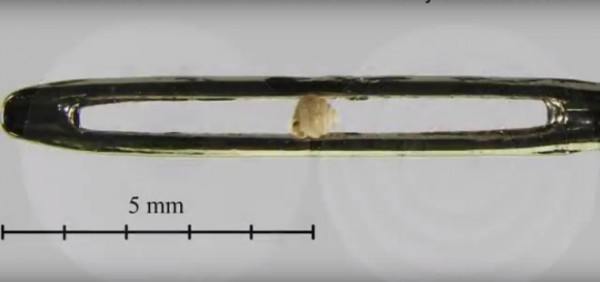Check Out World’s Smallest Snails Discovered in Southern China [Video]
| Antara Dutta Choudhury | | Sep 30, 2015 05:36 AM EDT |
A team of scientists discovered a snail species that has shell height of 0.86 mm, the tiniest ever snail discovered.
A team of scientists discovered a snail species that has shell height of 0.86 mm, the tiniest ever snail discovered.
The snail has been named as Angustopila dominikae. The snail that has been found by the scientist is an adult and it is as tiny as to fit through the head of needle and even smaller than the head of a match stick.
Like Us on Facebook
Researchers could only find shells of the snails in a sample of soil at the base of a limestone cliff in Guangxi, just north of Vietnam and thus details about the species still remains a mystery.
"We hope that these results provide the taxonomic groundwork for future studies concerning the evolution of dwarfism in invertebrates," the researchers said Nature World News.
Scientists believe that they have similar diet and lifestyle as compared to cave-inhabiting small snails that feed on microorganisms like bacteria and fungal filaments. These snails are hermaphrodite and have both male and female reproductive organs. It changes its sex according to the climate and based on the sex of the other snails around.
In an interview for Newsweek, Adrienne Jochum, a researcher at Switzerland's University of Bern and Bern Natural History Museum, shared that the round shape of the shells of these new species may enable them to slip into tiny cracks in rocks to trap air bubbles in their shell and float in water when it rains.
She added that the tiny size of the snails is an evolutionary advantage to survive from predators as they miss these tiny snails in search of larger preys.
The shells of the snails are made of calcium carbonate and require limestone to provide calcium to their shells.
Barna Páll-Gergely, scientist from Shinshu university in Japan and co-author of the research said, "These are very probably extreme endemic species. If we find them in more than one locality that is somewhat surprising."
TagsSmallest Snail, Tiniest Snail In The World, Smallest Snail In The World, Smallest Snail Found In China, World's Smallest Land Snail
©2015 Chinatopix All rights reserved. Do not reproduce without permission
EDITOR'S PICKS
-

Did the Trump administration just announce plans for a trade war with ‘hostile’ China and Russia?
-

US Senate passes Taiwan travel bill slammed by China
-

As Yan Sihong’s family grieves, here are other Chinese students who went missing abroad. Some have never been found
-

Beijing blasts Western critics who ‘smear China’ with the term sharp power
-

China Envoy Seeks to Defuse Tensions With U.S. as a Trade War Brews
-

Singapore's Deputy PM Provides Bitcoin Vote of Confidence Amid China's Blanket Bans
-

China warns investors over risks in overseas virtual currency trading
-

Chinese government most trustworthy: survey
-

Kashima Antlers On Course For Back-To-Back Titles
MOST POPULAR
LATEST NEWS
Zhou Yongkang: China's Former Security Chief Sentenced to Life in Prison

China's former Chief of the Ministry of Public Security, Zhou Yongkang, has been given a life sentence after he was found guilty of abusing his office, bribery and deliberately ... Full Article
TRENDING STORY

China Pork Prices Expected to Stabilize As The Supplies Recover

Elephone P9000 Smartphone is now on Sale on Amazon India

There's a Big Chance Cliffhangers Won't Still Be Resolved When Grey's Anatomy Season 13 Returns

Supreme Court Ruled on Samsung vs Apple Dispute for Patent Infringement

Microsoft Surface Pro 5 Rumors and Release Date: What is the Latest?












